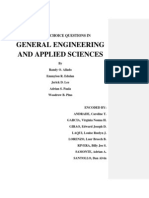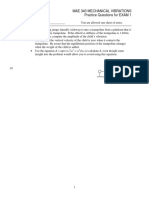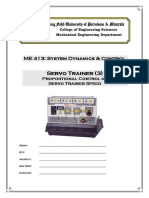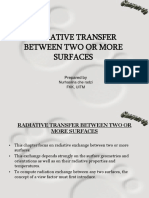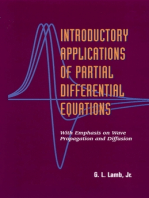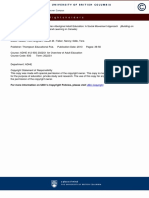Lab Experiment 8: Effect of Feedback On Disturbance & Control System Design Objective
Lab Experiment 8: Effect of Feedback On Disturbance & Control System Design Objective
Uploaded by
Kei DeeCopyright:
Available Formats
Lab Experiment 8: Effect of Feedback On Disturbance & Control System Design Objective
Lab Experiment 8: Effect of Feedback On Disturbance & Control System Design Objective
Uploaded by
Kei DeeOriginal Description:
Original Title
Copyright
Available Formats
Share this document
Did you find this document useful?
Is this content inappropriate?
Copyright:
Available Formats
Lab Experiment 8: Effect of Feedback On Disturbance & Control System Design Objective
Lab Experiment 8: Effect of Feedback On Disturbance & Control System Design Objective
Uploaded by
Kei DeeCopyright:
Available Formats
Lab Experiment 8: Effect of Feedback on disturbance & Control System
Design
Objective:
The objective of this exercise will be to study the effect of feedback on the response
of the system to step input and step disturbance taking the practical example of
English Channel boring machine and design a control system taking in account
performance measurement.
List of Equipment/Software
MATLAB
Overview:
The construction of the tunnel under the English Channel from France to the Great
Britain began in December 1987. The first connection of the boring tunnels from
each country was achieved in November 1990. The tunnel is 23.5 miles long and
bored 200 feet below sea level. Costing $14 billion, it was completed in 1992
making it possible for a train to travel from London to Paris in three hours.
The machine operated from both ends of the channel, bored towards the middle. To
link up accurately in the middle of the channel, a laser guidance system kept the
machines precisely aligned. A model of the boring machine control is shown in the
figure, where Y(s) is the actual angle of direction of travel of the boring machine and
R(s) is the desired angle. The effect of load on the machine is represented by the
disturbance, Td(s).
Figure: A block diagram model of a boring machine control system
Exercise 1:
a. Get the transfer function from R(s) to Y(s)
b. Get the transfer function from D(s) to Y(s)
c. Generate the system response; for K= 10, 20, 50, 100; due to a unit step input - r(t)
d. Generate the system response; for K= 10, 20, 50, 100; due to a unit step disturbance d(t)
e. For each case find the percentage overshoot(%O.S.), rise time, settling time, steady
state of y(t)
f. Compare the results of the two cases
g. Investigate the effect of changing the controller gain on the influence of the disturbance
on the system output
M-files for two cases of K=20 and K=100 are shown below
Due to unit step r(s)
% Response to a Unit Step Input R(s)=1/s
for K=20 and K=100
%
numg=[1];deng=[1 1 0];sysg=tf(numg,deng);
K1=100;K2=20;
num1=[11 K1];num2=[11 K2];den=[0 1];
sys1=tf(num1,den);sys2=tf(num2,den);
%
sysa=series(sys1,sysg);sysb=series(sys2,sysd);
sysc=feedback(sysa,[1]);sysd=feedback(sysb,[1]);
%
t=[0:0.01:2.0];
[y1,t]=step(sysc,t);[y2,t]=step(sysd,t);
subplot(211);plot(t,y1);title(Step Response for K=100);
xlabel(Time (seconds));ylabel(y(t));grid on;
subplot(212);plot(t,y2);title(Step Response for K=20);
xlabel(Time (seconds));ylabel(y(t));grid on;
Due to unit disturbance Td(s)
% Response to a Disturbance Input D(s)=1/s
for K=20 and K=100
%
numg=[1];deng=[1 1 0];sysg=tf(numg,deng);
K1=100;K2=20;
num1=[11 K1];num2=[11 K2];den=[0 1];
sys1=tf(num1,den);sys2=tf(num2,den);
%
sysa=feedback(sysg,sys1);sysa=minreal(sysa);
sysb=feedback(sysg,sys2);sysb=minreal(sysb);
%
t=[0:0.01:2.5];
[y1,t]=step(sysa,t);[y2,t]=step(sysb,t);
subplot(211);plot(t,y1);title(Disturbance Response for K=100);
xlabel(Time (seconds));ylabel(y(t));grid on;
subplot(212);plot(t,y2);title(Disturbance Response for K=20);
label(Time (seconds));ylabel(y(t));grid on;
Exercise 2:
Design of a Second order feedback system based on performances. For the motor
system given below, we need to design feedback such that the overshoot is limited
and there is less oscillatory nature in the response based on the specifications
provided in the table. Assume no disturbance (D(s)=0).
Table: Specifications for the Transient Response
Performance Measure
Desired Value
Percent overshoot :Less than 8%
Settling time :
Less than 400ms
Use MATLAB, to find the system performance for different values of Ka and find
which value of the gain Ka satisfies the design condition specified. Use the following
table.
You might also like
- Heat Exchanger ExperimentDocument48 pagesHeat Exchanger ExperimentAlicann CannNo ratings yet
- General Engineering and Applied Sciences 2nd Ed.Document625 pagesGeneral Engineering and Applied Sciences 2nd Ed.Aui Flora50% (2)
- Mass Spring Damper SystemDocument2 pagesMass Spring Damper SystemDivya Bharathi SNo ratings yet
- Aer416, Flight Mechanics SolutionsDocument2 pagesAer416, Flight Mechanics SolutionsUrshia Likes CookiesNo ratings yet
- Find The Transfer Function, For The System Shown Below. - : Example 1Document5 pagesFind The Transfer Function, For The System Shown Below. - : Example 1Neil Asher SiaNo ratings yet
- Experiment #1 Design and Verification of A Biquad Active FilterDocument3 pagesExperiment #1 Design and Verification of A Biquad Active FilterViky KumarNo ratings yet
- A Vented Tanker Is To Be Filled With Fuel Oil With PDocument4 pagesA Vented Tanker Is To Be Filled With Fuel Oil With PAbhay UpadhyayNo ratings yet
- Literature Review - Diversity and WorkDocument19 pagesLiterature Review - Diversity and WorkFunyIstrateNo ratings yet
- Closed Loop Response of Temperature Control SystemDocument6 pagesClosed Loop Response of Temperature Control SystemsjsujiprasadNo ratings yet
- Graphical SynthesisDocument58 pagesGraphical SynthesisAnas Asif100% (2)
- Separation of VariablesDocument13 pagesSeparation of VariablesxingmingNo ratings yet
- Exam1 PracticeDocument9 pagesExam1 PracticeashwaniNo ratings yet
- Vibrations of Multi-Degree of Freedom Systems: Simple Harmonic Motion That Passes Through Their Equilibrium PositionsDocument15 pagesVibrations of Multi-Degree of Freedom Systems: Simple Harmonic Motion That Passes Through Their Equilibrium PositionsMï XavierNo ratings yet
- Extended Surface Heat TransferDocument7 pagesExtended Surface Heat TransferAkay BayatNo ratings yet
- Truncation ErrorDocument3 pagesTruncation ErrorRashid AnzoomNo ratings yet
- The Integral Forms of The Fundamental LawsDocument16 pagesThe Integral Forms of The Fundamental LawsJenille C. Villanueva0% (1)
- Isentropic Process-Nozzle, Diffuser - Unit 1Document92 pagesIsentropic Process-Nozzle, Diffuser - Unit 1siddharth GautamNo ratings yet
- AC Air CyclesDocument18 pagesAC Air CyclesBilal Al Ali100% (2)
- Hartnell GovernorDocument3 pagesHartnell GovernorSoham DasNo ratings yet
- EX-Radial Temperature Distribution For SteadyDocument11 pagesEX-Radial Temperature Distribution For SteadyRasoul MohsenNo ratings yet
- CL7101-Control System DesignDocument8 pagesCL7101-Control System DesigndhineshpNo ratings yet
- HT Lecture 13 ConvectionSolvedProblemsDocument17 pagesHT Lecture 13 ConvectionSolvedProblemsclaudette colladoNo ratings yet
- ThwaitesDocument3 pagesThwaitesAhmed M. IbrahimNo ratings yet
- 4.11 Trapezoidal RuleDocument8 pages4.11 Trapezoidal RuleGian SanchezNo ratings yet
- Assignment 1: Turbo MachinesDocument2 pagesAssignment 1: Turbo MachineskookoNo ratings yet
- Free Vibration of One Degree of Freedom Systems: Initial DeviationDocument8 pagesFree Vibration of One Degree of Freedom Systems: Initial DeviationEugine BalomagaNo ratings yet
- CHE492 08 PC Flow Control TrainerDocument47 pagesCHE492 08 PC Flow Control TrainerAnkit Malhotra100% (2)
- Chapter 103 Even and Odd Functions and Half-Range Fourier SeriesDocument12 pagesChapter 103 Even and Odd Functions and Half-Range Fourier SeriesBaibhav MohantyNo ratings yet
- Lab11a - SERVO TRAINER 3 Proportional Control of Servo Trainer SpeedDocument9 pagesLab11a - SERVO TRAINER 3 Proportional Control of Servo Trainer SpeedsairafiNo ratings yet
- FM Module 3 ProbsDocument7 pagesFM Module 3 Probsyogesh shindeNo ratings yet
- ClassLectures Numerical MethodsDocument84 pagesClassLectures Numerical MethodsFaisal Baig50% (2)
- 03 Truncation ErrorsDocument37 pages03 Truncation ErrorsArturo Avila100% (1)
- Apsley-Turbulence Modelling in CFDDocument17 pagesApsley-Turbulence Modelling in CFDjuanarcos_778612No ratings yet
- Newton's Divided DifferenceDocument25 pagesNewton's Divided DifferencePonnammal KuppusamyNo ratings yet
- Solution For Chapter 4 Differential Flow PDFDocument24 pagesSolution For Chapter 4 Differential Flow PDFBowo Yuli PrasetyoNo ratings yet
- Chapter 3 TWO-DIMENSIONAL STEADY STATE CONDUCTIONDocument81 pagesChapter 3 TWO-DIMENSIONAL STEADY STATE CONDUCTIONYash MoreyNo ratings yet
- Chapter9E2010 PDFDocument29 pagesChapter9E2010 PDFmariahx91No ratings yet
- 8 de CFD FVM For Diffusion ProblemsDocument45 pages8 de CFD FVM For Diffusion ProblemsAmey LandgeNo ratings yet
- Chapter 13Document18 pagesChapter 13Anonymous lOMOpX3No ratings yet
- Bvp4c ExmamplesDocument33 pagesBvp4c ExmamplesMahmoud AhmedNo ratings yet
- HVAC Unit 2Document52 pagesHVAC Unit 2Rohini Shinde0% (1)
- Synchronous Machines-1Document41 pagesSynchronous Machines-1Rouxcel abutoNo ratings yet
- Hd-04 Impact of Jet On VanesDocument7 pagesHd-04 Impact of Jet On Vanesramniwas123No ratings yet
- The Discrete-Time Fourier TransformDocument10 pagesThe Discrete-Time Fourier TransformAsif AzizNo ratings yet
- Solution of State Space EquationDocument11 pagesSolution of State Space EquationAnirban MitraNo ratings yet
- Project Navier StokesDocument26 pagesProject Navier StokesYves GarnardNo ratings yet
- Rtmnu Questions: 1) A Discrete Probability Function F (X) Is AlwaysDocument16 pagesRtmnu Questions: 1) A Discrete Probability Function F (X) Is AlwaysVishwas PCNo ratings yet
- Answer On Question #11567-Physics-Molecular Physics-ThermodynamicsDocument3 pagesAnswer On Question #11567-Physics-Molecular Physics-ThermodynamicsMuhammad Haris KhattakNo ratings yet
- PID QuestionsDocument5 pagesPID QuestionsnivasssvNo ratings yet
- Lab Experiment # 03: ObjectiveDocument7 pagesLab Experiment # 03: ObjectiveMuhammad Samee baigNo ratings yet
- SISO Feedback LinearizationDocument24 pagesSISO Feedback LinearizationTarek Bmr100% (1)
- Propulsion Homework Exercises A 12-08Document11 pagesPropulsion Homework Exercises A 12-08jgolloberNo ratings yet
- Midterm Exam Vib 3 Industrial 2015Document3 pagesMidterm Exam Vib 3 Industrial 2015Judex OnyekabaNo ratings yet
- Control Theory Quiz 1Document5 pagesControl Theory Quiz 1Sundas Khalid100% (1)
- Feedback SystemDocument3 pagesFeedback SystemSeanne Cruz100% (2)
- Compressible Flow Across A Varying Area PassageDocument4 pagesCompressible Flow Across A Varying Area PassageGaurav VaibhavNo ratings yet
- Multi Degree of Freedom Systems - 1Document46 pagesMulti Degree of Freedom Systems - 1soqhNo ratings yet
- Answer For Tutorial 4Document4 pagesAnswer For Tutorial 4Prateek S Virdi100% (1)
- Dispersive Power of PrismDocument6 pagesDispersive Power of PrismSahil Aggarwal33% (3)
- Introductory Applications of Partial Differential Equations: With Emphasis on Wave Propagation and DiffusionFrom EverandIntroductory Applications of Partial Differential Equations: With Emphasis on Wave Propagation and DiffusionNo ratings yet
- Ege416 ProjectDocument6 pagesEge416 ProjectAddisu TsehayNo ratings yet
- Ch26b Midterm 2002Document7 pagesCh26b Midterm 2002Nguyễn Tiến DũngNo ratings yet
- F - G P W (H 11) W W: Evidence WitnessDocument6 pagesF - G P W (H 11) W W: Evidence WitnessKei DeeNo ratings yet
- Globe CFS: Itinerary ReportDocument1 pageGlobe CFS: Itinerary ReportKei DeeNo ratings yet
- ChemistryDocument14 pagesChemistryraennieNo ratings yet
- GEAS - Cybercrime & SafetyDocument1 pageGEAS - Cybercrime & SafetyKei DeeNo ratings yet
- Cebu - FB 10 - GEASDocument4 pagesCebu - FB 10 - GEASKei DeeNo ratings yet
- Cebu - FB 14 MathDocument4 pagesCebu - FB 14 MathKei DeeNo ratings yet
- Cebu - FB 12 - GEASDocument5 pagesCebu - FB 12 - GEASKei DeeNo ratings yet
- Elex - Coaching 1Document25 pagesElex - Coaching 1Kei DeeNo ratings yet
- Cebu - FB 7 - ESTDocument4 pagesCebu - FB 7 - ESTKei DeeNo ratings yet
- Coaching Ee 2Document13 pagesCoaching Ee 2Kei DeeNo ratings yet
- Elecs Superbook Answer KeyDocument47 pagesElecs Superbook Answer KeyChester Kyles Colita25% (4)
- Coaching Geas 1Document18 pagesCoaching Geas 1Kei DeeNo ratings yet
- The Beauty of HolinessDocument1 pageThe Beauty of HolinessKei DeeNo ratings yet
- Activity 3 in StatDocument13 pagesActivity 3 in StatIanna ManieboNo ratings yet
- Final RPDocument34 pagesFinal RPChristian ManiponNo ratings yet
- CH4: The Zone of Canadian Aboriginal Adult Education: A Social Movement ApproachDocument13 pagesCH4: The Zone of Canadian Aboriginal Adult Education: A Social Movement ApproachKawinNo ratings yet
- Maths Formula Pocket Book Maths Formula-Page62Document1 pageMaths Formula Pocket Book Maths Formula-Page62Ernie LahaylahayNo ratings yet
- Pre Board 2 Maths Answer KeyDocument7 pagesPre Board 2 Maths Answer KeyV MohithNo ratings yet
- Peds 2022057010Document24 pagesPeds 2022057010aulia lubisNo ratings yet
- Mahindra Black Belt Project Template - NewDocument66 pagesMahindra Black Belt Project Template - NewSharma MaheshNo ratings yet
- Pre-Test: Multiple Choice: Choose The Letter of The Correct Answer. Write Your Answer On ADocument20 pagesPre-Test: Multiple Choice: Choose The Letter of The Correct Answer. Write Your Answer On AI am julia VillagonzaloNo ratings yet
- Hafeez Taib Ki Nat GoeDocument11 pagesHafeez Taib Ki Nat GoeChand LalNo ratings yet
- Halaman Romawi Mawadah Kardina Dwi RahmawatiDocument80 pagesHalaman Romawi Mawadah Kardina Dwi RahmawatiElisa SiahaanNo ratings yet
- BOOK REVIEW (Shutter Island)Document3 pagesBOOK REVIEW (Shutter Island)Samina TohfaNo ratings yet
- How Can God Help MeDocument2 pagesHow Can God Help Mebright williamsnNo ratings yet
- Inclined Plane Experiment NewestDocument3 pagesInclined Plane Experiment Newestapi-238942037No ratings yet
- Spare The Rod and Spoil The Child EssayDocument7 pagesSpare The Rod and Spoil The Child Essayafabidbyx100% (2)
- Designing Listening Task SMADocument8 pagesDesigning Listening Task SMAJaenal AbidinNo ratings yet
- The Positive Parent Raising Healthy Happy and Successful Children Birth Adolescence PDFDocument265 pagesThe Positive Parent Raising Healthy Happy and Successful Children Birth Adolescence PDFSyibly Avivy A. MulachelaNo ratings yet
- Soal Bahasa Inggris Kelas Viii Semester 1 Tahun 2019Document8 pagesSoal Bahasa Inggris Kelas Viii Semester 1 Tahun 2019rahmiNo ratings yet
- Speech Outline ExampleDocument7 pagesSpeech Outline ExampleAriana PersaudNo ratings yet
- The-Scholarship-Jackest - Marta SalinasDocument10 pagesThe-Scholarship-Jackest - Marta SalinasChristen PaulsenNo ratings yet
- MilnerDocument2 pagesMilnerrbtakemoto100% (1)
- Wongyai, PotcharaDocument98 pagesWongyai, Potchara育宏林No ratings yet
- Lesson Plan September W2Document3 pagesLesson Plan September W2Christian Guillermo Aguilar CambronNo ratings yet
- ASCE702WDocument40 pagesASCE702WMadhubalan AlagarNo ratings yet
- Math 1010 Drug Filtering LabDocument6 pagesMath 1010 Drug Filtering Labapi-243252060No ratings yet
- I Wandered Lonely As A CloudDocument4 pagesI Wandered Lonely As A CloudMaricrisNo ratings yet
- Leading Psychiatrist Blows Whistle On ProfessionDocument9 pagesLeading Psychiatrist Blows Whistle On ProfessionpicogyoNo ratings yet
- Good Thesis Statement For Organ DonationDocument7 pagesGood Thesis Statement For Organ Donationamymilleranchorage100% (2)
- Tony Tan CaktiongDocument12 pagesTony Tan CaktiongKaye MalitNo ratings yet
- Resume: Ammunayakula Kalyani D/oDocument2 pagesResume: Ammunayakula Kalyani D/okalyaniammunayakulaNo ratings yet

